Contents
Market Overview
Macro Update
Markets were jolted early in the week by renewed U.S.-China trade tensions, following reports that the Trump administration is weighing new restrictions on software exports to China. The move came on the heels of Beijing’s fresh export controls and President Donald Trump’s threat of 100% tariffs. Sentiment improved, however, after the White House confirmed that Presidents Trump and Xi Jinping will meet during Mr. Trump’s Asia tour next week. In contrast, trade talks with Canada were abruptly suspended after Ottawa aired an ad featuring Ronald Reagan’s voice criticizing tariffs- an unusual but telling reminder of how unpredictable U.S. trade policy remains.
The delayed release of September CPI offered a welcome reprieve. Both headline and core inflation rose by less than expected (0.3% vs. 0.4% month-over-month; 3.0% vs. 3.1% year-over-year), keeping the Fed on course to cut rates next week. The softer data helped offset the drag from trade tensions. All major U.S. equity indices closed higher on the week, with Treasuries rallying (yields down ~5 bps, with the 10-year and 30-year just below 4.0% and 4.6%, respectively), and the dollar, while initially heading toward 99 on the DXY, eased as rate-cut expectations strengthened.
Commodities were volatile. Brent and WTI surged roughly 7%, back to the mid and low $60s, after Washington imposed sanctions on Russia’s largest oil producers and signaled further efforts to limit Russian exports to India and China. Gold, which had surged to an all-time high near $4,400/oz last week on fiscal worries in advanced economies, suffered its sharpest one-day drop since 2020, falling -5.3% on Tuesday, before stabilizing above $4,100/oz. Gold is still up nearly 60% year to date.
Other U.S. data painted a mixed picture. The University of Michigan’s final October sentiment index fell to a five-month low amid persistent inflation concerns, yet October PMIs surprised to the upside, showing the second-fastest expansion this year as firms balanced stronger orders with price restraint.
In Europe, the euro area’s preliminary October consumer confidence and PMIs both beat expectations. The UK’s September CPI surprised on the downside (3.8% vs. 4.0%, year-over-year). This bolstered the case for the Bank of England to resume rate cuts against a backdrop of tepid growth.
In China, the central bank left policy rates unchanged at 3.0%, consistent with expectations. The Fourth Plenum centered on the 2026–2030 plan, emphasizing rebalancing toward domestic demand, innovation, and technological self-sufficiency. Better-than-expected Q3 GDP, retail sales, and industrial output reinforced confidence that the country’s 5.0% full-year growth target remains attainable.
Across emerging markets, monetary policy stayed steady. Hungary held its main rate at 6.5%, while Indonesia surprised by holding at 4.75% instead of cutting. Türkiye delivered a well-telegraphed 100 bps cut to 39.5%, signaling a slower pace of easing amid elevated inflation and ongoing political uncertainty.
Elsewhere, geopolitical friction persisted. The Russia-Ukraine conflict continued with renewed missile and drone exchanges, while fresh U.S. sanctions on Russian oil suggested the conflict will likely extend a least into mid-2026. In Japan, Sanae Takaichi became the country’s first female prime minister after forming a coalition government; markets responded favorably, sending the Nikkei 225 index higher and the yen lower. In Bolivia, centrist Rodrigo Paz won the presidency, ending two decades of left-wing dominance under the MAS party – a development investors viewed as potentially precedent-setting for upcoming elections in Chile, Colombia, and Brazil.
EM Credit Update
Emerging Markets (EM) fixed income extended its recent momentum, delivering another week of solid gains. EM hard-currency sovereign bonds returned +0.55%, driven by high-yield names (+0.67%) outperforming investment grade (+0.42%). At the index level, spreads tightened 8 bps, reflecting an 11 bps compression in high yield and 5 bps in investment grade.
Performance was led by higher-beta regions, with Africa and Latin America outperforming, while Asia and the Middle East lagged amid greater rates sensitivity. Ethiopia was the top performer, as investors responded positively to signs of macro stabilization, including declining inflation, rising reserves, and tentative fiscal discipline. The positive reaction came despite ongoing uncertainty around eurobond restructuring. Venezuela also rallied as markets priced in a higher probability of regime change following escalating U.S. military pressure and the collapse of backchannel diplomacy. Reports of bomber deployments and covert action approvals heightened expectations of faster political transition and, consequently, debt restructuring.
By contrast, Lebanon surrendered last week’s gains amid renewed concerns over its unsustainable external imbalances and unreliable balance-of-payments data, which continue to undermine IMF engagement and investor confidence. Persistent political frictions, particularly Hezbollah’s opposition to reforms and regional tensions, remain obstacles to progress on restructuring and external support.
EM corporates advanced more modestly, up +0.17%, with spreads tightening 3 bps and performance broadly even between investment grade and high yield. CEMEEA outperformed on uniform strength across the region, while Latin America underperformed (-0.03%) on weakness in Trinidad and Tobago, where operational issues continue to weigh on methanol producer Consolidated Energy. Argentine corporates also lagged despite slightly improved sentiment at the sovereign level on the back of U.S. support.
Local-currency debt was broadly flat (+0.02%) as the recent dollar weakness paused. Brazil and Chile led gains. Brazil rebounded from last week’s losses on improved sentiment, and Chile benefitted from easing inflation, a supportive rate outlook, and stronger investor confidence ahead of November’s elections. Colombia underperformed amid renewed fiscal concerns and heightened political tensions with the U.S., while Thailand softened as U.S.-China trade noise resurfaced this week and the deputy finance minister stepped down amid criminal allegations.
Primary markets were slightly more active, with 13 new hard-currency deals across both investment-grade and high-yield issuers. Notable sovereign supply came from Kazakhstan, Korea, the Dominican Republic, and Uruguay, underscoring broad regional participation and still-open market access.
The Week Ahead
It’s a week of systemic global central banks’ policy decisions: the Fed, ECB, and BOJ will all meet to set interest rates. Markets expect the Fed to deliver another 25 bps cut to 4.0%, while the ECB (2.15%) and BOJ (0.5%) are expected to keep rates on hold. For the BOJ, this will be its first meeting since Sanae Takaichi — known as an advocate of monetary and fiscal easing — became Japan’s prime minister.
President Trump will visit Asia, where he is expected to meet with Chinese President Xi, Prime Minister Takaichi, and Brazilian President Luiz Inacio Lula da Silva, among others.
The week also includes Ivory Coast’s presidential elections on Saturday and Argentina’s closely watched midterm elections on Sunday. In Argentina, markets are expected to react to the performance of President Javier Milei’s party relative to the opposition. Investors are cautious following Mr. Milei’s underperformance in the Province of Buenos Aires elections last month. Regardless of the Sunday’s outcome, coalition building to improve governability and further evolution of economic policy will be key in the aftermath of the vote. Across emerging markets, central bank rate decisions are due in Chile, Colombia and Pakistan. South Korea, Spain, Czechia, the euro area, France, Germany, Hungary, Italy, Mexico, Saudi Arabia, Serbia and Taiwan will be reporting preliminary 3Q GDP growth numbers. Preliminary October inflation will be released in Germany, Spain, the eurozone, France, Italy, Japan, and Poland.
U.S. macro data on the docket include Dallas and Richmond Fed manufacturing indexes and consumer confidence surveys, as well as the core PCE price index, the Fed’s preferred inflation measure. In the world of corporate earnings, major companies such as Alphabet, Apple, Amazon, Meta, Exxon, and Chevron will report.
Fixed Income
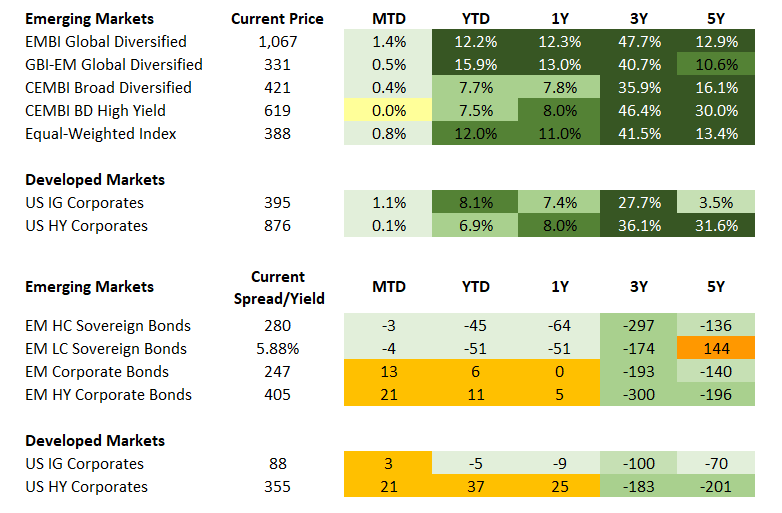
Equities
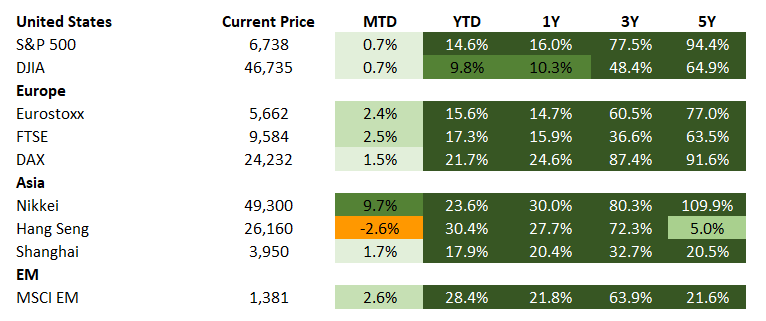
Commodities

Source for data tables: Bloomberg, JPMorgan, Gramercy. EM Fixed Income is represented by the following JPMorgan Indicies: EMBI Global, GBI-EM Global Diversified, CEMBI Broad Diversified and CEMBI Broad High Yield. DM Fixed Income is represented by the JPMorgan JULI Total Return Index and Domestic High Yield Index. Fixed Income, Equity and Commodity data is as of Oct. 24, 2025 (mid-day).
Highlights
Lula-Trump meeting in Malaysia Could Ease Brazil-U.S. Tensions
Event: Presidents Lula da Silva and Trump are expected to hold a face-to-face meeting on the sidelines of the Association of Southeast Asian Nations summit in Malaysia this weekend. This meeting would be the first since Mr. Trump’s return to the White House. The planned high-level encounter comes on the heels of the leaders’ phone call two weeks ago that both sides described as constructive and focused on economic issues rather than thorny ones, such as the prison sentence of former Brazilian President Jair Bolsonaro.
Gramercy Comment: The apparent constructive tone and frequency of recent Lula-Trump communication should bring down the temperature in a bi-lateral relationship that has been tense since the start of the Trump 2.0 administration. This would be credit-positive for Brazil. If noise around the U.S.-Brazil relationship subsides in the near-term, we expect to see some risk premium priced out, supporting Brazilian assets and especially the real, which is bolstered by attractive valuations and strong fundamentals.
However, we do not think markets should expect any material changes in the existing U.S. tariff framework on Brazil, which consists of 10% on all imports plus an additional 40% on around one-third of Brazil’s exports to the U.S., including coffee, beef, and ethanol. A thaw in bilateral relations may make some tariff carve-outs more likely, although trade with the U.S. has limited significance for Brazil’s large and domestically driven economy, so major concessions by Brasilia to Washington seem unlikely.
Over the medium term, the evolution of the Lula-Trump relationship could carry implications for domestic political dynamics in Brazil ahead of parliamentary and presidential elections in October 2026. Mr. Lula da Silva has enjoyed an improvement in his popularity lately, partly due to his criticism of President Trump’s policies on the global stage. This signals that it remains to be seen if a thaw between the two leaders would further boost Mr. Lula da Silva’s domestic popularity – or hurt it. The outcome of Brazil’s presidential elections next year carries material market relevance as it could significantly alter economic policy management.
Peru’s New President Announces State of Emergency
Event: On Wednesday, Peru’s Interim President Jose Jeri announced a state of emergency for 30 days to contain the fragile social situation following months of protests. Mr. Jeri, the country’s eighth president in the past decade, took over from President Dina Boluarte after Congress ousted her earlier this month on ‘moral incapacity’ and failure to curb crime. Mr. Jeri’s new cabinet points to policy continuity, while fresh elections are scheduled for April 2026. Market reaction has been muted thus far as presidential impeachments have become commonplace in Peru and macroeconomic policy usually remains intact.
Gramercy Comment: We expect the social backdrop and upcoming electoral cycle to be fluid, with more than 40 parties registered and new candidates still to emerge. As in past cycles, there is room for competitive, disruptive candidates.
Ultimately, the market will continue to care most about policy continuity to preserve the country’s robust balance sheet. It has a low debt to GDP ratio of around 33% and a solid foreign exchange reserve buffer. Preservation of Governor Julio Velarde, or someone of similar caliber, at the central bank, as well as key appointments at the Ministry of Economy and Finance, will be key.
Emerging Markets Technicals

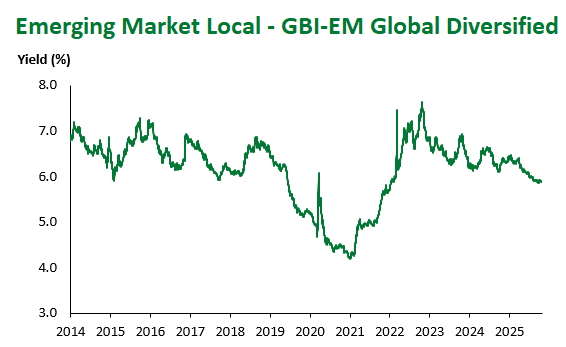

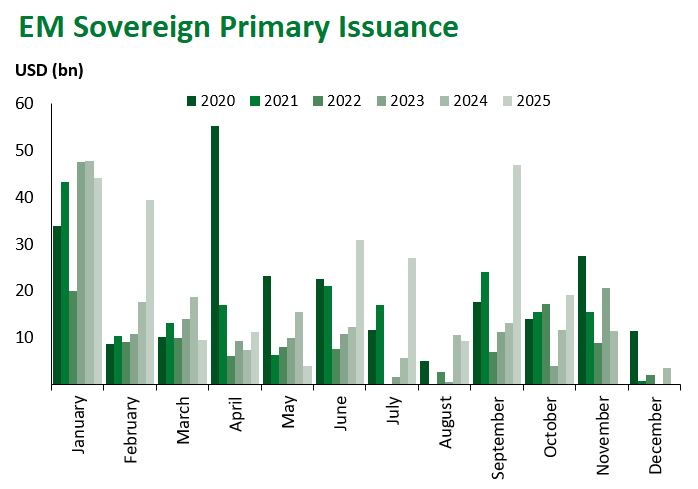
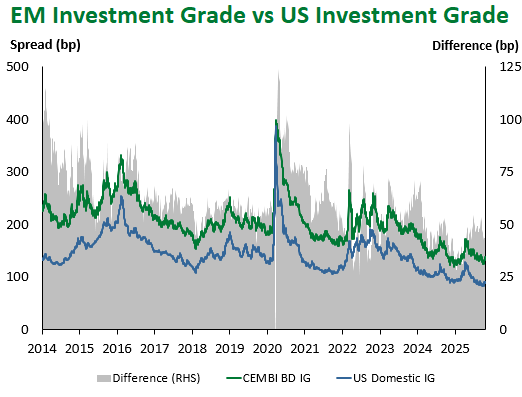
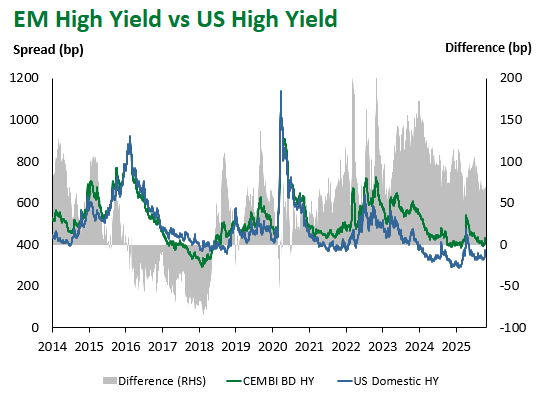
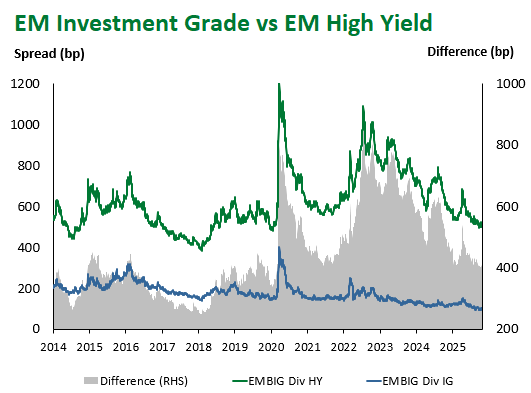
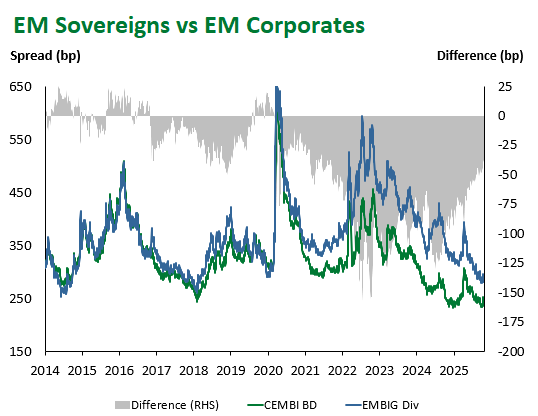
Emerging Markets Flows
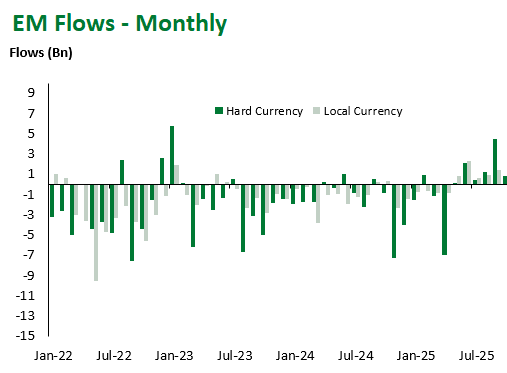

Source for graphs: Bloomberg, JPMorgan, Gramercy. As of Oct. 24, 2025.
For questions, please contact:
Kathryn Exum, CFA ESG, Director, Co-Head of Sovereign Research, [email protected]
Petar Atanasov, Director, Co-Head of Sovereign Research, [email protected]
This document is for informational purposes only. The information presented is not intended to be relied upon as a forecast, research or investment advice, and is not a recommendation, offer or solicitation to buy or sell any securities or to adopt any investment strategy. Gramercy may have current investment positions in the securities or sovereigns mentioned above. The information and opinions contained in this paper are as of the date of initial publication, derived from proprietary and nonproprietary sources deemed by Gramercy to be reliable, are not necessarily all-inclusive and are not guaranteed as to accuracy. This paper may contain “forward-looking” information that is not purely historical in nature. Such information may include, among other things, projections and forecasts. There is no guarantee that any forecasts made will come to pass. Reliance upon information in this paper is at the sole discretion of the reader. You should not rely on this presentation as the basis upon which to make an investment decision. Investment involves risk. There can be no assurance that investment objectives will be achieved. Investors must be prepared to bear the risk of a total loss of their investment. These risks are often heightened for investments in emerging/developing markets or smaller capital markets. International investing involves risks, including risks related to foreign currency, limited liquidity, less government regulation, and the possibility of substantial volatility due to adverse political, economic or other developments. References to any indices are for informational and general comparative purposes only. The performance data of various indices mentioned in this update are updated and released on a periodic basis before finalization. The performance data of various indices presented herein was current as of the date of the presentation. Please refer to data returns of the separate indices if you desire additional or updated information. Indices are unmanaged, and their performance results do not reflect the impact of fees, expenses, or taxes that may be incurred through an investment with Gramercy. Returns for indices assume dividend reinvestment. An investment cannot be made directly in an index. Accordingly, comparing results shown to those of such indices may be of limited use. The information provided herein is neither tax nor legal advice. Investors should speak to their tax professional for specific information regarding their tax situation.
